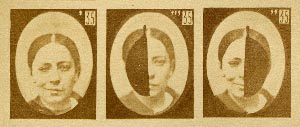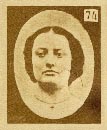
ART. IV.---Electro-Physiognomy. A Condensed Resume from the Work of M. Duchenne (de Boulogne). By M. L. EDGEWORTH, M. D.
THE muscles of the human face are not like those of our limbs, all and completely subject to the will, although they spontaneously and involuntarily contract under the influence of emotions, and express these physiognomically by the lines and folds, the tensions or distentions of the skin which rounds our features. In the words of the distinguished electrician, to whose work we now invite attention,1
" The soul alone, normally, enjoys the faculty of producing these expressions faithfully. They are, then, so fugitive that the greatest artists have not always succeeded in reproducing the ensemble of their distinctive traits."
All the expressions of which the face is susceptible, through the contraction of its muscles severally and combinedly, may be imitated, by their contractions as induced by the electric current. The orthography of physiognomy, the anatomical rules of expression, whether voluntary or involuntary, may be deciphered by faradization, which is electro-magnetism localized by rheophores. It is said that Sir Charles Bell, and Sarlandiere, employed galvanism in their physiognomical experiments. The "Philosophy of Expression" is, however, of later date than the work of Moreau de la Sarthe, a collaborator with Lavater, who had preoccupied the ground with immense talent of observation and anatomical intuition, and who, in great measure, anticipated Bell's conclusions.
M. Duchenne has photographed his faces at the moment when a certain muscle or muscles, in contracting under the rheophores of an electro-magnet, give a characteristic expression to the countenance.
A muscle, such as that which contracts the eyebrow, expressive by graduated moderate contractions of many degrees of suffering, ceases to be morally expressive at its most powerful contraction, or spasm, as under a flash of light. In repeating these experiments, we are admonished to graduate the current delicately, as each degree of intensity excites a corresponding contraction of the muscle upon which the rheophores direct it, and elicits corresponding shades of expression.
By coating the rheophores with wet buckskin, the current penetrates the muscle more directly.
A grimace, rather than a true physiognomic expression, is produced by the action of the current on the larger branches of the seventh pair, or motor nerve of the face, because too many muscles at once are thus excited. Grimaces are also produced by the simultaneous contractions of muscles which do not group or harmonize in a natural physiognomic expression.
Expressions induced upon one side of the face only, must produce the effect of grimaces, if we look at both sides of the face at once. The reader is, therefore, requested to conceal, as indicated, such or such a part of each of these photographs, while the opposite part is considered; then the expression of the face will be completely designed, and often become one of great beauty.
It is difficult to localize the action of the rheophores exactly, because the current often meets one or two motor branches repairing to a neighboring muscular fascicle; either when it is too intense, or from some anomaly in the nervous distribution. Thus, in the right side of Photograph 35, the current has excited the eyelid muscles slightly, at the same time with the great zygomatic.

Unless the face of the subject be insensible, as was that of an old man on whom M. Duchenne experimented, the operator should gently accustom it to the contact of the rheophores before interpreting physiognomically the contractions witnessed. The natural expressions of pain, surprise, etc., will then cease to complicate the experiment.

"The female model photographed (Fig. 74) is a young woman nearly blind by atrophy of the papillae of the optic nerves, and whose face had been frequently electrified during her treatment for this amaurosis. She cannot see the gestures or the attitudes in which I place her and drape her, just as if I were acting upon a manikin.
1Mécanisme de la Physionomie Humaine, ou analyse électro-physiologique de l'expression des passions des arts plastiques. Par le Docteur G. B. Duchenne (de Boulogne). Paris, 1862.
